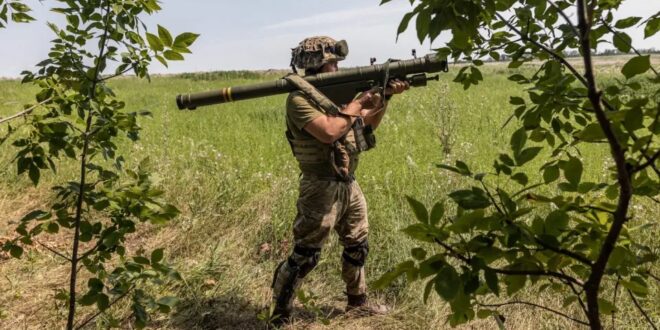As NATO leaders and other key officials gather in Washington this week to commemorate the alliance’s 75th anniversary, they must avoid talk of celebration. The world is in turmoil, and they must focus hard on explaining to their various agitated and unsure constituents what their strategy really is for the Ukraine war.
At present, the war is basically stuck, but there is more momentum on the Russian side in terms of battlefield territory, political developments in relevant key countries and long-term demographic and economic factors. Under these circumstances, it makes little sense to keep repeating the tired mantra that we will help Ukraine “for as long as it takes.” That is not a strategy.
Nor is President Biden’s broader campaign slogan of “let’s finish the job.” Biden and his team, whether or not he stays in the race, have done their fair share of the job to date, but there is no clarity at all on where we are now heading.
In terms of ensuring Ukrainian survival and sovereignty, we should help Ukraine for as long as it takes. Indeed, NATO leaders and voters on both sides of the Atlantic (as well as Japan, South Korea, Australia and New Zealand — all also represented at the summit) should take pride in what they have helped Ukraine do so far. It was crucial that Russia be prevented from taking over the country, or stealing most of its territory and resources, when Russian President Vladimir Putin launched his unconscionable and unprovoked invasion 29 months ago. Otherwise, NATO territory might have been next in the sights of the Russian dictator.
It is also important to note that, as we have documented with our Ukraine Index at Brookings, Europe has actually done more than the U.S. to help Ukraine in terms of overall economic, military, humanitarian and refugee support. Former President Trump has frequently said otherwise, but he is wrong on that point, even if he is correct that America’s NATO allies must still do more to provide for their own defense as a matter of fair alliance burden-sharing.
But it is not so obvious that Western security hinges on Ukraine reclaiming the 18 percent of its original (pre-2014) territory that Russia currently holds. To be sure, what Russia has done in Ukraine is tragic, especially the terrible human toll. But core American interests do not necessarily include where a border is drawn some 1,000 miles from the original places where NATO’s eastern borders were originally established during the Cold War.
It would be wrong for NATO leaders to try to impose a specific outcome on Ukraine right now. Although our security is at play, too, and although our enormous collective contributions to Ukraine’s defense should give us a say in war-termination strategies, it is too soon to ask a sovereign country and admirable friend to accept the theft of nearly one-fifth of its own land by a ravenous imperialist neighbor.
We may someday have to hold our noses and acknowledge that much of what Russia now controls in eastern and southern Ukraine is not going to be won back on the battlefield. But Ukraine deserves another try at a serious counteroffensive. To be sure, the odds are against it. I have estimated elsewhere that Ukraine would need to build a crack maneuver force of some 200,000 more troops to have a good chance at success, and there are few signs that its military is building such a capability. But I still think Ukrainians deserve one more chance; it is, after all, their land.
All of this suggests the contours of a strategy that NATO leaders should, at least in general terms, begin to discuss privately and even publicly this week. For now, we should indeed provide Ukraine almost everything it could ask for. Give Ukraine the rest of the year and into 2025 to build up its capabilities and attempt a major counteroffensive. But don’t plan on complete success.
Meanwhile, allow politics in the U.S., France and elsewhere to settle a bit — or at least clarify their course. Start talking with Ukrainian President Volodymyr Zelensky about how Western aid might be modified. And yes, cut back in some ways in 2025 if his next offensive does not succeed. At that point, depending on circumstances, consider falling back on a strategy that helps Ukraine protect the land it does hold, as well as Ukrainian cities from air and missile attack, while helping the country recover economically and build up its long-term defensibility.
There is one more key piece to all of this too — Ukraine’s security anchor to the West. Most favor NATO membership for Ukraine. But that will most likely never prove negotiable with Moscow and may not be practical anytime soon.
Lise Howard of Georgetown University and I have proposed an Atlantic-Asian Security Community instead. This would include the U.S. and some other key Western countries, and possibly other countries like India, as well as Ukraine (and maybe Russia someday, off in the distant future). Among other activities, this partnership would deploy a dense network of military trainers in uniform, but not organized in combat formations, throughout those parts of Ukraine controlled by Kyiv, perhaps even before the war ends, to act as a tripwire against future Russian attack.
The stated intent of members of this partnership would be to intervene to protect their trainers if they were ever threatened.
This concept may be too much to propose publicly right now. But the broad contours of a more realistic strategy should no longer be taboo for discussion. NATO leaders owe increasingly skeptical constituents a better answer to David Petraeus’s famous question about Iraq: “Tell me how this ends.”
 Eurasia Press & News
Eurasia Press & News




